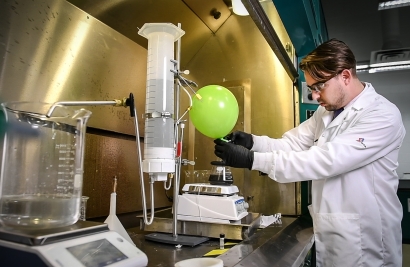
Scientists at the U.S. Army Aberdeen Proving Grounds Research Laboratory were conducting the tests when they observed a bubbling reaction when adding water to a nano-galvanic aluminum-based powder.
"We all as a team were very excited and ecstatic that something good had happened," said Dr. Anit Giri, a physicist with the lab's Weapons and Materials Research Directorate.
The team further investigated and found that water split apart when it came into contact with their unique aluminum nanomaterial. Typically, aluminum exposed to water oxidizes, creating rust to prevent further reactions from occurring. In this case, though, the hydrogen-producing reaction just kept going.
"The hydrogen that is given off can be used as a fuel in a fuel cell," said Scott Grendahl, a materials engineer and team leader. "What we discovered is a mechanism for a rapid and spontaneous hydrolysis of water."
Scientists have known for a long time that hydrogen can be produced by adding a catalyst (a substance that increases a chemical reaction rate) to aluminum. However, previous methods took more time, elevated temperature, added electricity, and/or toxic chemicals such as sodium hydroxide, potassium hydroxide or acid.
"In our case, it does not need a catalyst," Giri said. "Also, it is very fast. For example, we have calculated that one kilogram of aluminum powder can produce 220 kilowatts of energy in just three minutes."
The team adapted their findings to power a small radio-controlled tank with the powder and water reaction. Moments after mixing the powder with a small amount of water, a bubbling reaction produced a great deal of hydrogen, which was then used to power the model around the laboratory.
Grendahl said the discovery is dramatic in terms of its future potential.
"There are other researchers who have been searching their whole lives and their optimized product takes many hours to achieve, say 50% efficiency," Grendahl said. "Ours does it to nearly 100% efficiency in less than three minutes."
For information: https://www.army.mil/article/191212/army_discovery_may_offer_new_energy_source
Photo caption: Army researcher Anthony J. Roberts inflates a balloon with hydrogen produced from a chemical reaction between water and an aluminum nanomaterial powder discovered at the U.S. Army Research Laboratory at Aberdeen Proving Ground, Maryland. (Photo Credit: U.S. Army photo by David McNally)

